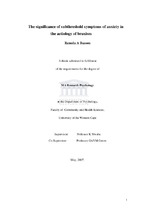| dc.contributor.advisor | Mwaba, K | |
| dc.contributor.advisor | Geerts, Gavm | |
| dc.contributor.author | Basson, Reneda A. | |
| dc.contributor.other | Dept. of Psychology | |
| dc.contributor.other | Faculty of Community and Health Sciences | |
| dc.date.accessioned | 2013-10-11T08:28:21Z | |
| dc.date.available | 2009/07/22 06:21 | |
| dc.date.available | 2009/07/22 | |
| dc.date.available | 2013-10-11T08:28:21Z | |
| dc.date.issued | 2007 | |
| dc.identifier.uri | http://hdl.handle.net/11394/2234 | |
| dc.description | Magister Artium (Psychology) - MA(Psych) | en_US |
| dc.description.abstract | Bruxism is an oral parafunctional habit involving clenching and grinding of the teeth that occurs mainly unconsciously, diurnally and nocturnally. It is considered an important contributory factor in the aetiology of myofascial pain (MFP) and temporomandibular disorders (TMD). The aetiology of bruxism is considered to be multifactorial, involving physiological and psychological factors. The aim of this study was to examine the relationship between the subthreshold symptoms (subtle, prodromal, atypical and subclinical symptoms of which the severity precludes diagnosis as a disorder) of anxiety and bruxism in a sample of subjects using a spectrum model. | en_US |
| dc.language.iso | en | en_US |
| dc.publisher | University of the Western Cape | en_US |
| dc.subject | Myofascial pain syndromes | en_US |
| dc.subject | Treatment | en_US |
| dc.subject | Muscles | en_US |
| dc.subject | Anxiety | en_US |
| dc.subject | Anxiety disorders | en_US |
| dc.subject | Diagnosis | en_US |
| dc.title | The significance of subthreshold symptoms of anxiety in the aetiology of bruxism | en_US |
| dc.type | Thesis | en_US |
| dc.rights.holder | University of the Western Cape | en_US |
| dc.description.country | South Africa | |

